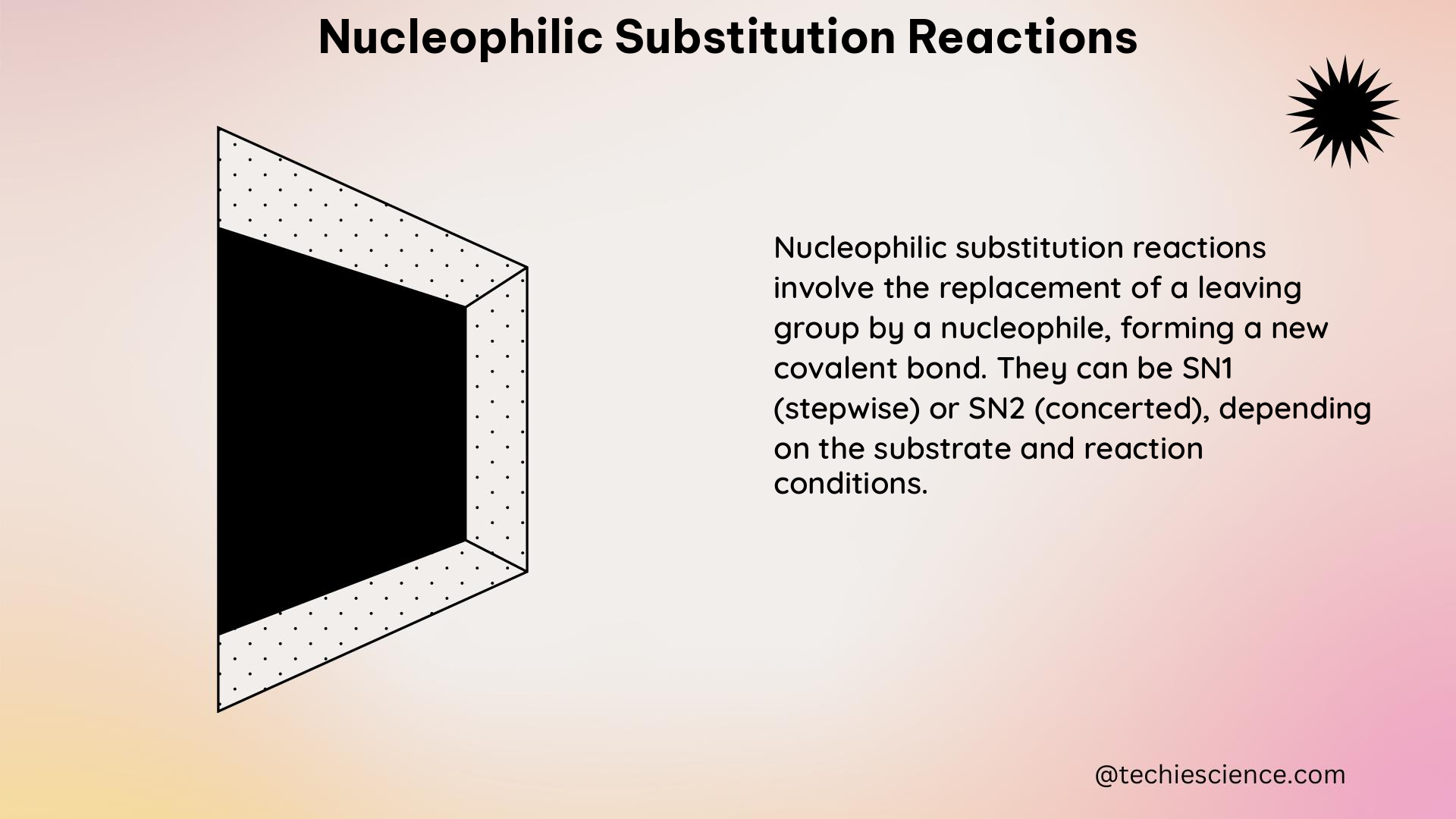Nucleophilic substitution reactions (NSRs) are fundamental in organic chemistry, where a nucleophile (:N) attacks a substrate (R-L) forming a new bond and releasing a leaving group (:L). The reaction rate and mechanism of NSRs depend on the substrate, nucleophile, and leaving group’s nature, as well as solvent effects.
Understanding Reaction Kinetics
Nucleophilic substitution reactions can follow two major mechanisms: SN1 and SN2.
SN1 Reactions
SN1 reactions display first-order kinetics, where the rate of the reaction depends on the concentration of the substrate. The mechanism involves the formation of a carbocation intermediate, which is then attacked by the nucleophile. The rate-determining step is the formation of the carbocation, and the reaction is favored in substrates with tertiary or benzylic carbocations.
The rate equation for an SN1 reaction is:
Rate = k[R-L]
where k is the rate constant and [R-L] is the concentration of the substrate.
SN2 Reactions
SN2 reactions exhibit second-order kinetics, where the rate of the reaction depends on the concentrations of both the substrate and the nucleophile. The mechanism involves a backside attack of the nucleophile on the substrate, leading to the inversion of configuration at the central carbon atom.
The rate equation for an SN2 reaction is:
Rate = k[R-L][Nu]
where k is the rate constant, [R-L] is the concentration of the substrate, and [Nu] is the concentration of the nucleophile.
Stereochemistry of Nucleophilic Substitution

SN2 reactions are stereospecific, with backside attack and inversion of configuration at the central carbon atom. This can be observed through the change in optical activity of chiral substrates before and after the reaction.
For example, in the reaction of (R)-2-bromobutane with sodium hydroxide, the product will be (S)-2-butanol, demonstrating the inversion of configuration.
(R)-2-bromobutane + NaOH → (S)-2-butanol
Leaving Group Ability
The reactivity of a nucleophilic substitution reaction is strongly influenced by the nature of the leaving group. Leaving groups with weak bonds to the substrate, such as C-I, exhibit enhanced reactivity compared to those with stronger bonds, such as C-F.
The relative leaving group ability can be ranked as follows:
I- > Br- > Cl- > F-
This trend can be explained by the stability of the leaving group and the ease of bond cleavage. Iodide is the best leaving group due to its large size and high polarizability, which stabilizes the negative charge developed during the reaction.
Nucleophile Strength
The strength of the nucleophile is another crucial factor in determining the rate and mechanism of nucleophilic substitution reactions. Stronger bases, such as alkoxide ions (RO-) and amide ions (R2N-), are better nucleophiles and tend to favor the SN2 pathway.
However, for very strong nucleophiles, an E2 (elimination, bimolecular) pathway might be favored over the SN2 pathway. This is because the strong nucleophile can abstract a proton from the β-carbon, leading to the formation of an alkene product instead of the substitution product.
Solvent Effects
The nature of the solvent can significantly impact the rate and mechanism of nucleophilic substitution reactions. Solvation of ionic intermediates in NSRs can raise the activation barriers and change the shape of the potential energy surface (PES).
For example, in protic solvents (e.g., water, alcohols), the nucleophile and leaving group can be solvated, stabilizing the transition state and favoring the SN2 pathway. In aprotic solvents (e.g., DMSO, DMF), the ionic intermediates are less solvated, which can lead to a higher SN1 character.
Structural Effects
The structure of the alkyl halide substrate can also affect the barriers for both SN2 and E2 pathways. Steric hindrance around the reaction center can impede the backside attack of the nucleophile in SN2 reactions, favoring the SN1 pathway.
For instance, the reaction of tert-butyl bromide with hydroxide ion (OH-) is much slower than the reaction of ethyl bromide with the same nucleophile. This is due to the increased steric hindrance around the tertiary carbon in tert-butyl bromide, which makes the SN2 pathway less favorable.
CH3CH2Br + OH- → CH3CH2OH + Br- (faster)
(CH3)3CBr + OH- → (CH3)3COH + Br- (slower)
Additionally, the presence of electron-withdrawing groups (e.g., halogens) on the substrate can stabilize the carbocation intermediate in SN1 reactions, making the SN1 pathway more favorable.
Anomeric Effect and Nucleophilic Substitution
The anomeric effect is a crucial factor in understanding the reactivity of certain substrates, such as halogenated cyclic ethers, towards nucleophilic substitution. The anomeric effect arises from the interaction between the free electron pair on the halogen atom and the antibonding σ* orbital of the neighboring C-O bond, lowering the energy of the free-electron-pair-orbital and stabilizing the compound.
This stabilization can make the substrate less reactive towards nucleophilic attack, as observed in the case of dichloromethane (CH2Cl2) and chloroform (CHCl3). The anomeric effect, combined with the steric hindrance exerted by the second chlorine atom in DCM, contributes to the resistance of these compounds towards nucleophilic substitution.
Conclusion
Nucleophilic substitution reactions are fundamental in organic chemistry, and understanding the factors that influence their rate and mechanism is crucial for successful synthetic transformations. By considering the reaction kinetics, stereochemistry, leaving group ability, nucleophile strength, solvent effects, and structural factors, chemists can design and optimize NSRs to achieve their desired outcomes.
References:
1. Amherst College, Experiment 7 — Nucleophilic Substitution, https://www.amherst.edu/system/files/media/0931/Exp7.pdf
2. NCBI, Nucleophilic Substitution (SN2): Dependence on Substrate, Nucleophile, and Leaving Group, https://www.ncbi.nlm.nih.gov/pmc/articles/PMC6001448/
3. UCSB, Organic Chemistry, Nucleophilic Substitution, https://people.chem.ucsb.edu/neuman/robert/orgchembyneuman.book/07%20NucleophilicSubstitution/07FullChapt.pdf
4. Chemistry Stack Exchange, Why are DCM and chloroform so resistant towards nucleophilic substitution, https://chemistry.stackexchange.com/questions/15690/why-are-dcm-and-chloroform-so-resistant-towards-nucleophilic-substitution
5. AZoM, Benchtop NMR and Nucleophilic Substitution, https://www.azom.com/article.aspx?ArticleID=16497

The lambdageeks.com Core SME Team is a group of experienced subject matter experts from diverse scientific and technical fields including Physics, Chemistry, Technology,Electronics & Electrical Engineering, Automotive, Mechanical Engineering. Our team collaborates to create high-quality, well-researched articles on a wide range of science and technology topics for the lambdageeks.com website.
All Our Senior SME are having more than 7 Years of experience in the respective fields . They are either Working Industry Professionals or assocaited With different Universities. Refer Our Authors Page to get to know About our Core SMEs.